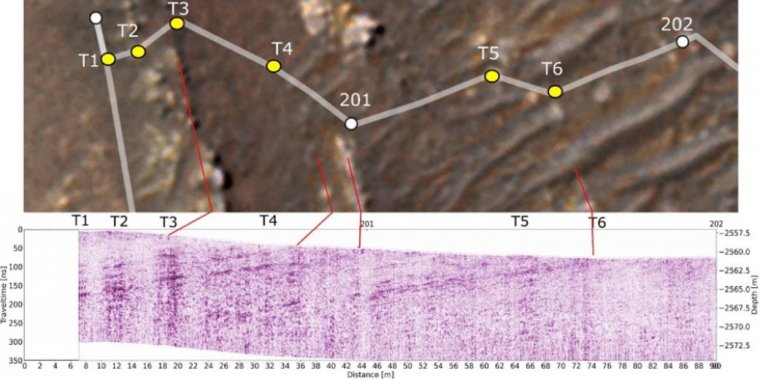| News / Space News |
NASA’s Perseverance Mars Rover Makes Surprising Discoveries
Scientists with NASA’s Perseverance Mars rover mission have discovered that the bedrock their six-wheeled explorer has been driving on since landing in February likely formed from red-hot magma. The discovery has implications for understanding and accurately dating critical events in the history of Jezero Crater – as well as the rest of the planet.

This graphic depicts Perseverance’s entry into “Séítah” from both an orbital and subsurface perspective. Photo: NASA/JPL-Caltech/University of Arizona/USGS/FFI
The team has also concluded that rocks in the crater have interacted with water multiple times over the eons and that some contain organic molecules.
The drill at the end of Perseverance’s robotic arm can abrade, or grind, rock surfaces to allow other instruments, such as PIXL, to study them. Short for Planetary Instrument for X-ray Lithochemistry, PIXL uses X-ray fluorescence to map the elemental composition of rocks.
On Nov. 12, PIXL analyzed a South Séítah rock the science team had chosen to take a core sample from using the rover’s drill. The PIXL data showed the rock, nicknamed “Brac,” to be composed of an unusual abundance of large olivine crystals engulfed in pyroxene crystals.
“A good geology student will tell you that such a texture indicates the rock formed when crystals grew and settled in a slowly cooling magma – for example a thick lava flow, lava lake, or magma chamber,” said Farley.
“The rock was then altered by water several times, making it a treasure trove that will allow future scientists to date events in Jezero, better understand the period in which water was more common on its surface, and reveal the early history of the planet. Mars Sample Return is going to have great stuff to choose from!”
The multi-mission Mars Sample Return campaign began with Perseverance, which is collecting Martian rock samples in search of ancient microscopic life.
Of Perseverance’s 43 sample tubes, six have been sealed to date – four with rock cores, one with Martian atmosphere, and one that contained “witness” material to observe any contamination the rover might have brought from Earth.
Mars Sample Return seeks to bring select tubes back to Earth, where generations of scientists will be able to study them with powerful lab equipment far too large to send to Mars.
Still to be determined is whether the olivine-rich rock formed in a thick lava lake cooling on the surface or in a subterranean chamber that was later exposed by erosion.
Also great news for Mars Sample Return is the discovery of organic compounds by the SHERLOC (Scanning Habitable Environments with Raman & Luminescence for Organics & Chemicals) instrument. The carbon-containing molecules are not only in the interiors of abraded rocks SHERLOC analyzed, but in the dust on non-abraded rock.
Confirmation of organics is not a confirmation that life once existed in Jezero and left telltale signs (biosignatures). There are both biological and non-biological mechanisms that create organics.
The preservation of organics inside ancient rocks – regardless of origin – at both Gale and Jezero Craters does mean that potential biosignatures (signs of life, whether past or present) could be preserved, too.
“This is a question that may not be solved until the samples are returned to Earth, but the preservation of organics is very exciting. When these samples are returned to Earth, they will be a source of scientific inquiry and discovery for many years,” said Luther Beegle, SHERLOC principal investigator at NASA’s Jet Propulsion Laboratory in Southern California.
Along with its rock-core sampling capabilities, Perseverance has brought the first ground-penetrating radar to the surface of Mars. RIMFAX (Radar Imager for Mars' Subsurface Experiment) creates a “radargram” of subsurface features up to about 33 feet (10 meters) deep.
Data for this first released radargram was collected as the rover drove across a ridgeline from the “Crater Floor Fractured Rough” geologic unit into the Séítah geologic unit.
The ridgeline has multiple rock formations with a visible downward tilt. With RIMFAX data, Perseverance scientists now know that these angled rock layers continue at the same angle well below the surface.
The radargram also shows the Séítah rock layers project below those of Crater Floor Fractured Rough. The results further confirm the science team’s belief that the creation of Séítah preceded Crater Floor Fractured Rough.
A key objective for Perseverance’s mission on Mars is astrobiology, including the search for signs of ancient microbial life.
The rover will characterize the planet’s geology and past climate, pave the way for human exploration of the Red Planet, and be the first mission to collect and cache Martian rock and regolith (broken rock and dust). (NASA)
YOU MAY ALSO LIKE




